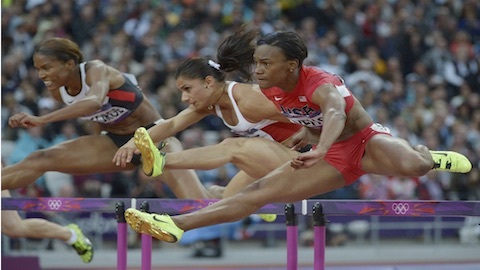Intersex athletes

Intersex athletes have been in the news a lot in recent years, as high-profile female runners like Caster Semenya and Dutee Chand come under scrutiny for having some physical features commonly associated with men.
These controversies aren't new. For decades, rumors and speculation have swirled around female athletes who have been suspected of either being men or having an intersex variation that results in an unfair advantage.
The assumption is that men hold an inherent advantage over women when it comes to physical competition, and that some intersex conditions might give an unfair advantage to female athletes.
Doubts have been especially intense for elite women athletes competing on the international stage. In the 1936 Olympics, two U.S. runners--Stella Walsh and Helen Stephens--fell under suspicion of being men. Fierce competitors, Walsh and Stephens were renowned for their record-breaking races--and their unusual physical appearance. Both women had musculature and facial features more commonly seen in men.
According to the authors of "Intersex and the Olympic Games," published in the Journal of the Royal Society of Medicine,
"Rumors circulated the Games that both Walsh and Stephens were men, competing with the wrong sex to gain unfair advantage." (Ritchie et al., 2008, p. 1)
After Stephens narrowly edged out Walsh in the 100-meter sprint, Walsh publicly accused Stephens of being male:
"Since no formal gender verification program existed at this time, the Olympic committee felt compelled to perform a sex check on Stephens. This sex test was a crude physical examination involving the gross inspection of the external genitalia; it confirmed Stephens possessed female external genitalia." (Ritchie et al., 2008, p. 1)
Stephens got to keep her medal. But In following decades, sports authorities employed various means of "gender verification" with elite female athletes, from gynecological examinations to testing chromosomes and DNA. As a result, many athletes who were found to have an intersex variation were barred from competing.
The authors of "Intersex and the Olympic Games" assert:
"Notably, gender testing in athletics has never identified an individual deliberately misrepresenting their gender. Testing has, however, created controversy and embarrassment for a significant number of female athletes competing, often unknowingly, with some form of intersex disorder. ("Ritchie et al., 2008, p. 5)
In 1999, the International Olympic Committee (IOC) ceased the practice of mandatory gender verification for Olympic athletes. However, this did not end the debates swirling around intersex and sports. Most recently, these controversies have centered on female athletes with specific intersex variations that result in exceptionally high levels of functional testosterone.
In 2019, the Swiss-based Court of Arbitration for Sport issued a ruling regarding the regulation of testosterone levels in athletes who compete as women in select track and field events. This ruling was based on data suggesting that it is ultimately the presence of testes--and the production of functional testosterone--that gives male runners (and some intersex women) a substantial advantage. In other sports, recent policies of world governing bodies have similarly focused on regulating levels of functioning testosterone for elite athletes who compete as women.
Featured Content
Read about the 2019 Court of Arbitration for Sport ruling regarding testosterone levels in this article, published in the New York Times.
Track and Field Tries to Understand New Rules for Female Athletes
The Court of Arbitration for Sport's 2019 ruling was in response to regulations for female athletes issued by the world governing body for track and field, the International Association of Athletics Federation (IAAF) in 2018. Read about the debates stirred by the IAAF's regulations in these two contrasting opinion pieces published in the New York Times.
Sex, sport, and why track and field's new rules on intersex athletes are essential
Track's absurd new rules for women
Check out the full article published in the Journal of the Royal Society of Medicine to learn more about the history of gender verification in women's sports and why the authors believe it's hard to draw clear distinctions when it comes to biological sex.
References:
Coleman, D. (2018, April 30). Sex, sport, and why track and field's new rules on intersex athletes are essential. New York Times. https://www.nytimes.com/2018/04/30/sports/track-gender-rules.html
Dreger, A. (2018, April 27). Track's absurd new rules for women. New York Times. https://www.nytimes.com/2018/04/27/opinion/caster-semenya-intersex-athletes.html
Kolata, Gina. (2019, May 8). Track and Field Tries to Understand New Rules for Intersex Athletes. New York Times. https://www.nytimes.com/2019/05/08/sports/semenya-xy-chromosomes.html
Ritchie, R., Reynard, J., & Lewis, T. (2008). Intersex and the Olympic Games. Journal of the Royal Society of Medicine, 101(8), 395-399. https://www.ncbi.nlm.nih.gov/pmc/articles/PMC2500237/
World Athletics. (2018, April 26). IAAF introduces new eligibility regulations for female classification [Press release]. https://www.iaaf.org/news/press-release/eligibility-regulations-for-female-classifica
Dee
Who is Dee?
Gender Identity
 Our core sense of who we are as a man, a woman, a mixture of both, or neither.
Our core sense of who we are as a man, a woman, a mixture of both, or neither.
Gender Expression
 How we show up in the world through choices like clothing, hair style, mannerisms or tone of voice.
How we show up in the world through choices like clothing, hair style, mannerisms or tone of voice.
Attraction
 How we feel toward others sexually, romantically and/or emotionally.
How we feel toward others sexually, romantically and/or emotionally.
Biological Sex
 Physical attributes such as reproductive organs and genitalia, chromosomes, genes and hormone levels.
Physical attributes such as reproductive organs and genitalia, chromosomes, genes and hormone levels.
Explore More
Read the official report from the IAAF on the new eligibility regulations.
